Podalyria calyptrata
Podalyria calyptrata (Retz.) Willd.
Family: Fabaceae
Common names: sweetpea bush, large pink keurtjie, water blossom-pea (Eng.); keur, keurtjie, keurblom, ertjiebos, waterkeurtjie (Afr.)
Introduction
There are few shrubs to beat Podalyria calyptrata , with its attractive, glossy, silvery foliage and masses of sweet-scented mauve-pink sweetpea-like flowers in spring, and it is easy to grow. It's also an excellent plant for the gardener wanting to attract bees, butterflies and birds to the garden.
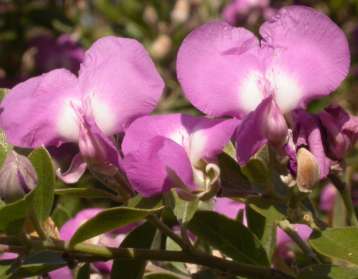
Description
Description
Podalyria calyptrata is a sturdy, fast-growing, well-branched shrub of 2-3 m or a small tree of 4-5 m. The leaves are simple, alternate and oval or egg-shaped, 10-45 mm long and up to 25 mm wide, green-grey in colour and sparsely covered with silky white hairs on the upper and lower surfaces that give the leaves a silvery sheen. Young growth is velvety.

The flowers are large, 25 mm or more across, very showy, mauve-pink to pink, most have a white spot in the centre, usually visible on the standard petal, and very occasionally you find a bush where the whole flower is white. Flowers are borne in winter-spring-early summer (July-Oct.). Flowering time varies in that some bushes flower earlier than others in the same area. Flowering is extended - bushes start off attractively dotted with their large flowers and in full bloom are completely covered in flowers.
The flowers are typically pea-like with the standard/banner, keel and wing petals; the keel completely encloses the stamens and the stigma. They are also strongly fragrant, and really do 'fill the air of whole valleys with their sweet scent' (Marloth in Palmer & Pitman 1972), a scent that reminds me of some grape-flavoured sweets of my childhood.
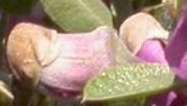
When in bud, the flowers are covered by small, hairy bracts joined together to form a silken cap, which turns pale brown and appears to shrink as the bud grows, until it is balanced on the tip of the bud and falls off as the flower opens. It is an obvious feature once you notice it, and it distinguishes Podalyria calyptrata from all other species of Podalyria .
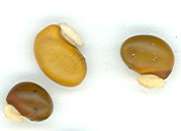
The flowers are followed by hard, inflated, furry brown pods roughly 40 x 15 mm. They are found on the bushes from about October until January or later. The pods split to release several small seeds with a fleshy, collar-like aril.
Distribution and habitat
Distribution description
Podalyria calyptrata is a fynbos plant and occurs in the winter rainfall Western Cape from the Cape Peninsula northwards to Tulbagh and eastwards to Potberg near Bredasdorp and Swellendam. It is common on sandstone slopes in kloofs (ravines), on moist hillsides, in marshy places, beside mountain streams and on forest margins. It is generally found below 1 000 m. It is abundant on the Kirstenbosch Estate, on the eastern slopes of Table Mountain above the garden, and forms part of many plantings in the garden.
Derivation of name and historical aspects
History
The genus Podalyria was named by Lamarck after Podalirius/Podalyrius (Latin) from Podaleirios (Greek), the son of Asklepios, god of healing. According to the Iliad, Podaleirios and his brother Machaon were physicians to the Greek army during the Trojan Wars. The specific name calyptrata comes from the characteristic cap that covers the flower buds, the Latin calyptrata meaning 'bearing a cap-like covering'.
Podalyria calyptrata has acquired quite a few common names over the years. Its first recorded common name is keurtjie (pronounced cure-key), in use as far back as 1860-about the same time that the virgilias acquired the name keurboom. Keurtjie is the diminutive of keur, the Dutch word meaning 'choice' or 'the pick of', a name it attracted because of its showy flowers. The name keurtjie is applied to several podalyrias as well as some species of Psoralea , Rafnia and the sutherlandias, usually distinguished by flower colour as pink keurtjie, bloukeurtjie (blue keurtjie), geelkeurtjie (yellow keurtjie) and rooikeurtjie (red keurtjie) respectively. The common name ertjiebos (pea-bush) is also applied to several species of Podalyria and Rafnia and refers to the pea-like pods.
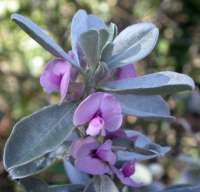
Podalyria is a genus of 25 species, endemic to southern Africa. Most podalyrias occur in the winter rainfall region of South Africa, some extend into the Eastern Cape and a few into the Northern Cape or KwaZulu-Natal. All have simple, alternate leaves, and most have showy pink or white pea-like flowers. Podalyria belongs in the tribe Podalyrieae, subfamily Papilionoideae, family Fabaceae. Its closest relatives are Virgilia , Cyclopia and Stirtonanthus . At Kirstenbosch at the moment, we have only one other species in the garden, P. sericea , the silky podalyria, a small shrub up to 1 m, with silky, silvery foliage and small pink and white flowers. It occurs on sandstone and granite outcrops below 500 m from Saldanha Bay to the Cape Peninsula.
Ecology
Ecology
Podalyria calyptrata flowers are very attractive to many insects, particularly carpenter bees, and nectar-feeders like honey bees, butterflies and hoverflies. The large, heavy carpenter bees land on the petals and their weight opens the flower, giving them access to the pollen and nectar, whereas the smaller, lighter, honey bee goes to the opening at the base of the petals, gaining access to the nectar. The insects that are attracted by the flowers attract insect-eating birds like the Cape Batis.
Uses
Use
Podalyria calyptrata appears to be purely decorative as no records of other uses could be traced.
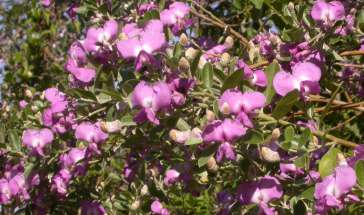
Growing Podalyria calyptrata
Grow
Podalyria calyptrata is quick and easy to grow. It does best in well-drained, well-composted, acidic soil and in summer rainfall areas it must be watered well in autumn and winter. It does not thrive in alkaline soils. Podalyria calyptrata is wind-tolerant and drought tolerant, but it performs best in a well-watered position. Although Podalyria calyptrata comes from a frost-free climate, it does tolerate frost; it is considered to be frost hardy on the Highveld and should survive outdoors in Zone 9 (-7 to -1 o C/20-30 o F) . In cold climates it is best grown in the cool glasshouse.
Plant Podalyria calyptrata along a boundary to provide an informal hedge or screen. With its attractive foliage and flowers, it can be planted in the mixed border, or as a backdrop. It makes a handsome specimen plant, or rewarding container plant in a large pot. To achieve a more compact, bushy specimen, plant it in full sun and pinch back young growth. In a shady spot it will grow taller and be more sparsely branched.
Podalyria calyptrata is best propagated by seed. Podalyrias do not root easily from cuttings, and the plants are never as strong as seed-grown plants. Seed can be sown in autumn or spring. Soak the seed in warm to hot water (water that you can put your hand in) until the water cools and sow. Podalyrias like most legumes are very susceptible to pre-emergence damping off and treating the seed and/or the seed trays with a fungicide to combat this will improve the percentage of surviving seedlings. Sow the seed into plugs, or into individual bags or pots, or prick them out while they are still in the cotyledon-stage i.e. before the first pair of true leaves develops. We find that this minimizes root disturbance and maximizes the number of surviving seedlings.
References
- Argent, S. & Loedolff, J. 1997. Discovering indigenous forests at Kirstenbosch . University of Cape Town Press.
- Burman, L. & Bean, A. 1985. Hottentots Holland to Hermanus . South African Wild Flower Guide 5. Botanical Society of South Africa, Cape Town.
- Coates Palgrave, M. 2002. Keith Coates Palgrave Trees of southern Africa , edn 3. Struik, Cape Town.
- Germishuizen, G. & Meyer, N.L. (eds). 2003. Plants of southern Africa: an annotated checklist. Strelitzia 14. National Botanical Institute, Pretoria.
- Goldblatt, P. & Manning, J. 2000. Cape plants. A conspectus of the Cape flora of South Africa. Strelitzia 9. National Botanical Institute, Pretoria & Missouri Botanical Garden Press, Missouri.
- Jackson, W.P.U. 1990. Origins and meanings of names of South African plant genera . University of Cape Town.
- Joffe, P. 1993. The gardener's guide to South African plants . Tafelberg, Cape Town.
- Leistner, O.A. (ed.). 2000. Seed plants of southern Africa: families and genera. Strelitzia 10. National Botanical Institute, Pretoria.
- Palmer, E. & Pitman, N. 1972. Trees of southern Africa . Balkema, Cape Town.
- Schelpe, A.S.L. 1987. Podalyria calyptrata. The Flowering Plants of Africa 49: t. 1958.
- Smith, C.A. 1966. Common names of South African plants. Memoirs of the Botanical Survey of South Africa No. 35.
Credits
Alice Notten
Kirstenbosch National Botanical Garden
November 2004
Plant Attributes:
Plant Type: Shrub
SA Distribution: Western Cape
Soil type: Sandy
Flowering season: Spring, Winter
PH: Acid
Flower colour: Pink, Mauve/Lilac
Aspect: Full Sun
Gardening skill: Easy
Special Features:
Horticultural zones











Rate this article
Article well written and informative
Rate this plant
Is this an interesting plant?
Login to add your Comment
Back to topNot registered yet? Click here to register.